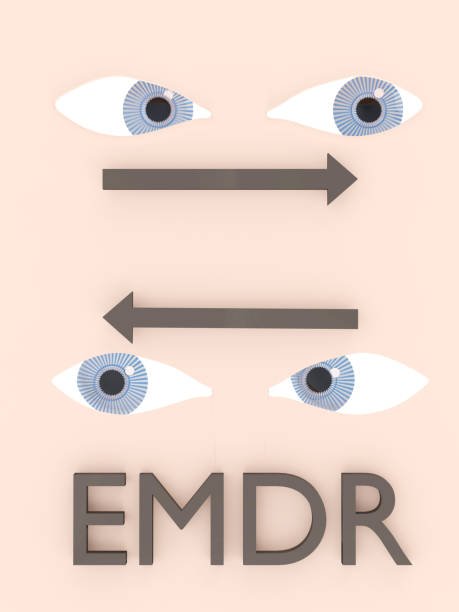
What is Eye Movement Desensitization and Reprocessing?
Any professional engaged in trauma treatment will have a dream in his heart, hoping to find a faster way to help clients so that their suffering days can be shortened. Currently, Eye Movement Desensitization and Process Renewal Therapy (EMDR) created by Dr. Francine Shapiro makes this dream come true.
Since eye movement desensitization and process updating therapy was officially recognized by the American Psychological Association, legendary stories about this psychotherapy method have been heard in the public. For example, this method helped people and rescue workers who were injured in the attack on the Oklahoma City Government Building to get out of the haze of the incident. In addition, some police personnel or firefighters also heard that they benefited from this kind of treatment. beneficial.
Eye Movement Desensitization and Process Renewal Therapy has evolved from a simple technique to an integrated psychotherapy theory. In addition to obviously alleviating the clients’ painful emotions, this type of treatment can also take into account their inner self-growth and the integration of their external social resource systems.
Origin of theory
Shapiro began to realize in 1987 that eye movements have an impact on people’s psychological state. However, if we want to talk about the origin of this theory, we have to estimate it to 1979. At the time, she was working on her doctoral thesis in English literature at New York University. While working on her thesis, she became interested in the causal relationships between psychological phenomena and physiological aspects of humans. At this time, she had been diagnosed with breast cancer, which made her cherish the years she had even more. Her understanding of the physiological causal reactions advocated by behaviorist scholars was particularly meaningful at this moment. . So she focused her attention on the interaction between an individual’s inner psychology and external pressures.
Later, when she learned that Norman Cousins and others were conducting research on neurology and psychoimmunology, she became even more convinced that disease and stress were related. When she was told that the cancer cells in her body had been completely removed, but she was not sure whether they would reappear and everything depended on her luck, she began to actively participate in various programs that emphasized the promotion of mental, physical and psychological health. Methods and other workshops to enhance her physical and mental health. So she further studied for a doctorate in clinical psychology, and took the relationship between physical and mental health and stress as the topic of her thesis. The theory of Eye Movement Desensitization and Reprocessing (EMDR) has also been formally constructed and developed.

The meaning of eye movements
Basically, the so-called eye movement means that the therapist moves his fingers left and right in front of the client, or claps his hands, so that the client’s vision can move from one end to the other according to this rhythm, thereby inducing the client’s nerve conduction. system. As for the distance between the therapist and the client, it depends on whether the client feels comfortable. Shapiro also pointed out based on his clinical experience that in addition to left and right parallel movements, there are also up and down movements, or diagonal movements. Each type has its own special effects. It is best for the therapist to decide which type to use and the moving speed that the client can accept for EMDR after discussing it with the client.
Since the beginning of this theory comes from Shapiro’s own personal experience, when constructing this theory, she attaches great importance to the client’s psychological state and needs, and points out that the client is the person who can best help the therapist learn. . Therefore, the therapist must carefully look at the client’s overall state of perception, thinking, feeling, behavior, and beliefs. In other words, during the treatment process, the therapist must be client-centered, which is also the professional service attitude emphasized by this therapy.
Adaptive message processing
According to the literature, if humans can establish a good attachment relationship with their caregivers during childhood, the cortical part of the brain will develop well, making them better able to develop the ability to self-soothe and self-integrate. This therapy uses the eye movement step to enable clients to establish a higher-level cognitive process and enable the cortical areas of the brain to function, so that their original cognitive content can be transformed.
After conducting many clinical experiments, Shapiro discovered that the information theory was better than the desensitization hypothesis in explaining the impact of eye movements on clients. Therefore, after changing the name, he adopted the Adaptive Information Processing (AIP) model as his model. The core claims of this therapy. She also emphasized that the terminology used in this model is derived from the neurophysiological information processing theory proposed by G.H. Bower and P.J. Lang in the 1980s. She uses the term adaptive to point out that appropriate connections will be made during this process, and these experiences are individual and can be integrated into a positive emotional and cognitive schema. She also emphasized that the negative memories stored in people’s brains must be dealt with no matter how long they are stored, otherwise people will not be able to gain true freedom.
Shapiro believes that when the client’s traumatic memories go through this therapy, the client must directly face these memories that have been stored in the brain, thus activating the client’s nerve conduction system, and the direction of conduction will naturally move towards helping The client is more capable of the process of self-adjustment, which is the so-called adaptive information processing. The two-way activation methods include moving the eyes left and right, tapping the knees, flashing light sticks, bilateral auditory stimulation, etc., and are based on the client’s special conditions. Adjust it as needed.

Treatment results
Wilson, Becker, & Tinker (1995) evaluated the effects of treatment on 80 traumatized clients who had received EMDR three times, and pointed out that EMDR had significant effects, which prompted clinical practitioners to begin to pay attention to the psychological role of EMDR. The value of therapeutic areas. Later, Wilson et al. followed these subjects for fifteen months, and their research results pointed out that 84% of the subjects no longer had symptoms of PTSD (Wilson, Becker, & Tinker, 1997). Later, as more effectiveness research results pointed out that EMDR has therapeutic effects, the American Psychiatric Association also highly affirmed the therapeutic effect of EMDR (American Psychiatric Association, 2004).
Because EMDR helps clients face their past life experiences, it allows them to clarify negative emotions and memories, and to look at past events with new eyes, allowing them to take their lives into their own hands and let them He can be freed from the troubles of his past. Therefore, EMDR can be said to integrate the concepts advocated by psychodynamic theory, behavioral theory, cognitive theory, empirical school, hypnotherapy, and systems theory. Therefore, as Shapiro said, no matter which school of thought you want to attribute this therapy to, the most important thing is not which school of thought you belong to, but to be able to treat the client as a whole person. This is That’s the point.
Research and Development
In order to promote this therapy to all parts of the world, the EMDR Federation has set up an international academic organization and website (i.e. www.emdria.org), and encourages helpers everywhere to make local adjustments so that EMDR can increase its richness.












